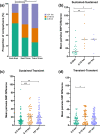Widespread sharing of pneumococcal strains in a rural African setting: proximate villages are more likely to share similar strains that are carried at multiple timepoints
- PMID: 35119356
- PMCID: PMC8942022
- DOI: 10.1099/mgen.0.000732
Widespread sharing of pneumococcal strains in a rural African setting: proximate villages are more likely to share similar strains that are carried at multiple timepoints
Abstract
The transmission dynamics of Streptococcus pneumoniae in sub-Saharan Africa are poorly understood due to a lack of adequate epidemiological and genomic data. Here we leverage a longitudinal cohort from 21 neighbouring villages in rural Africa to study how closely related strains of S. pneumoniae are shared among infants. We analysed 1074 pneumococcal genomes isolated from 102 infants from 21 villages. Strains were designated for unique serotype and sequence-type combinations, and we arbitrarily defined strain sharing where the pairwise genetic distance between strains could be accounted for by the mean within host intra-strain diversity. We used non-parametric statistical tests to assess the role of spatial distance and prolonged carriage on strain sharing using a logistic regression model. We recorded 458 carriage episodes including 318 (69.4 %) where the carried strain was shared with at least one other infant. The odds of strain sharing varied significantly across villages (χ2=47.5, df=21, P-value <0.001). Infants in close proximity to each other were more likely to be involved in strain sharing, but we also show a considerable amount of strain sharing across longer distances. Close geographic proximity (<5 km) between shared strains was associated with a significantly lower pairwise SNP distance compared to strains shared over longer distances (P-value <0.005). Sustained carriage of a shared strain among the infants was significantly more likely to occur if they resided in villages within a 5 km radius of each other (P-value <0.005, OR 3.7). Conversely, where both infants were transiently colonized by the shared strain, they were more likely to reside in villages separated by over 15 km (P-value <0.05, OR 1.5). PCV7 serotypes were rare (13.5 %) and were significantly less likely to be shared (P-value <0.001, OR -1.07). Strain sharing was more likely to occur over short geographical distances, especially where accompanied by sustained colonization. Our results show that strain sharing is a useful proxy for studying transmission dynamics in an under-sampled population with limited genomic data. This article contains data hosted by Microreact.
Keywords: pneumococcal transmission dynamics; rural African setting.
Conflict of interest statement
The authors declare that there are no conflicts of interest.
Figures



References
Publication types
MeSH terms
LinkOut - more resources
Full Text Sources
Medical
Miscellaneous

